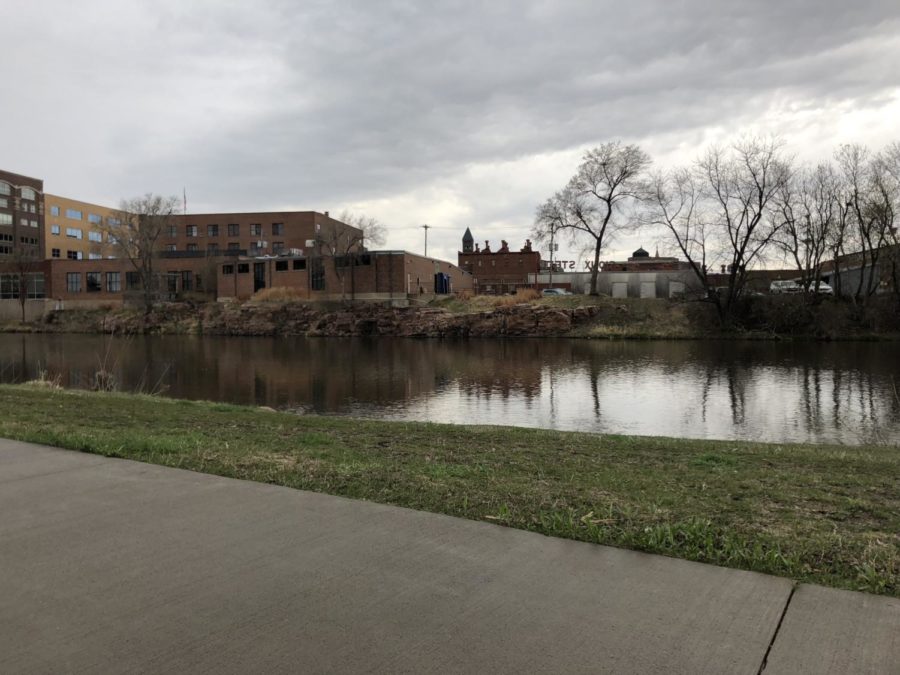Make the Big Sioux River swimmable
May 8, 2018
There was a time when the people of SD could take a leisurely swim in the Big Sioux River, knowing that the water was safe, swimmable and clean. Due to erosion, pollution and runoff, this is no longer the case.
The Big Sioux River, which was designated by the Department of Environment and Natural Resources to be swimmable, exceeds swimmability in E. Coli levels, suspended solid levels and nitrates, runoffs from fertilizers. Friends of the Big Sioux River is a nonprofit advocacy and awareness organization that aims to bring awareness to the challenges facing the river, as well as work toward cleaning the Big Sioux River and making it swimmable by 2025. They are trying to target the nonpoint source pollution that affects the river by asking people to take ownership for their part in causing it.
“Nonpoint source can come from runoff from this railyard, runoff from parking lots, runoff from your lawns, runoff from building sites, runoff from farm fields, from cattle in the river, from all different sites,” said Director Dana Loseke. “And so it’s kind of a nonspecific point, but we know that all that stuff collectively adds up. So a little bit from you, a little bit from me, a little bit from businesses, a little bit from farms; everybody thinks that what they’re doing is just a little bit, but when you add it all together, it really makes a horrendous difference, a detriment to the river… we all have to work together as one big community to fix it.”
In addition, Friends of the Big Sioux River is going to replace the turf grass by parts of the Big Sioux River with a prairie grass riparian buffer strip, which will stop soil erosion and act as a filter to stop chemical runoffs from fertilizers, herbicides and pesticides. They will decide where to put these buffer strips through their mapping project, in which they look at Google Earth along the Big Sioux River Watershed and divide the land into categories like buffer strip areas, cropland, park land and urban development. That information will be put into a land use study that will help them better understand where to put in buffer strips, where there could be better landscape practices or better management and where they might have to target big livestock operations and ask them to be a part of the solution.
Friends of the Big Sioux River is also going to test the water of the Big Sioux River in places where there is public access, such as at Lake Alvin or Falls Park and anywhere where people often use the river, such as at canoe points. They will post the E. Coli levels, TSS levels and the nitrate levels on their website so that people can stay better informed about how safe the river is. Additionally, they will continue their education and awareness projects about nonpoint pollution.
“I think we’ve achieved a lot more awareness of the problems,” said Loseke. “A lot of people are beginning to realize it’s something that needs to be cared about. The Chamber of Commerce backs it, the City of Sioux Falls backs it, even the state legislature realizes that we’ve got to do something better than the way we treat our rivers today.”
There are a number of reasons why they chose to use making the Big Sioux River swimmable as their goal. For one, swimability is the designated standard for the river. Swimability is also the safest standard. Making the river swimmable in turn makes it usable for livestock watering, recreation, canoeing and drinking. They also believe that a mission statement of making the Big Sioux River swimmable resonates a lot more than just cleaning the river.
“If I just told you, ‘Hey, we’re trying to clean up the Big Sioux River, you’d think we’re going to pick up trash,” said Loseke. “No. We’re going to make it swimmable again. And it’s amazing how many people that are 80 and 90 years old hear that and they say, ‘Man, I remember when I used to swim up at Dell Rapids and they had all those waterslides.’”
To help Friends of the Big Sioux River achieve their goals, there are a number of changes that could be made. For one, they are a volunteer organization that always needs more volunteers. On top of that, they are always looking for funding.
“We need more funding so we can have a full time director that would actually be able to create more awareness and funds that would help us target things that need to be done on the river,” said Loseke.
Another way for people to help is for them to be mindful of their actions by using better landscaping practices at home, stopping livestock waste from polluting waterways and encouraging legislation that protects the Big Sioux River.
“If you’ve got a house with a lawn, and you’re fertilizing that lawn, you’re probably a part of the problem,” said Loseke. “If you’re putting salt on your sidewalks and your streets during the middle of winter, that’s part of the problem. If you’re driving a car and you’re antifreeze boils over and you leak some gas and some oil once in a while, you’re part of the problem. So everybody can do just a little bit better and that makes a huge difference.”



![IMG_6232[1]](https://lhsstatesman.com/wp-content/uploads/2018/05/IMG_62321-900x675.jpg)






